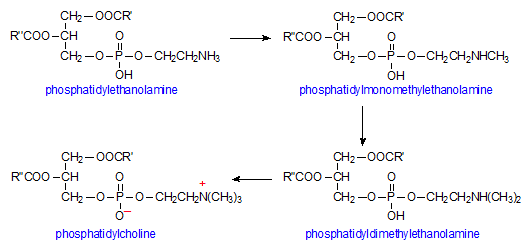 | ||
Phosphatidylcholines (PC) are a class of phospholipids that incorporate choline as a headgroup. They are a major component of biological membranes and can be easily obtained from a variety of readily available sources, such as egg yolk or soybeans, from which they are mechanically or chemically extracted using hexane. They are also a member of the lecithin group of yellow-brownish fatty substances occurring in animal and plant tissues. Dipalmitoyl phosphatidylcholine (a.k.a. lecithin) is a major component of pulmonary surfactant and is often used in the L/S ratio to calculate fetal lung maturity. While phosphatidylcholines are found in all plant and animal cells, they are absent in the membranes of most bacteria, including Escherichia coli. Purified phosphatidylcholine is produced commercially.
Contents
- Structure and physical properties
- Senescence
- Liver repair
- Lipolysis
- Ulcerative colitis
- Possible health risks
- References
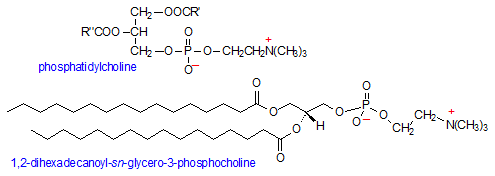
The name "lecithin" was originally defined from the Greek lekithos (λεκιθος, egg yolk) by Theodore Nicolas Gobley, a French chemist and pharmacist of the mid-19th century, who applied it to the egg yolk phosphatidylcholine that he identified in 1847. Gobley eventually completely described his lecithin from chemical structural point of view, in 1874. Phosphatidylcholines are such a major component of lecithin that in some contexts the terms are sometimes used as synonyms. However, lecithin extracts consist of a mixture of phosphatidylcholine and other compounds. It is also used along with sodium taurocholate for simulating fed- and fasted-state biorelevant media in dissolution studies of highly lipophilic drugs.
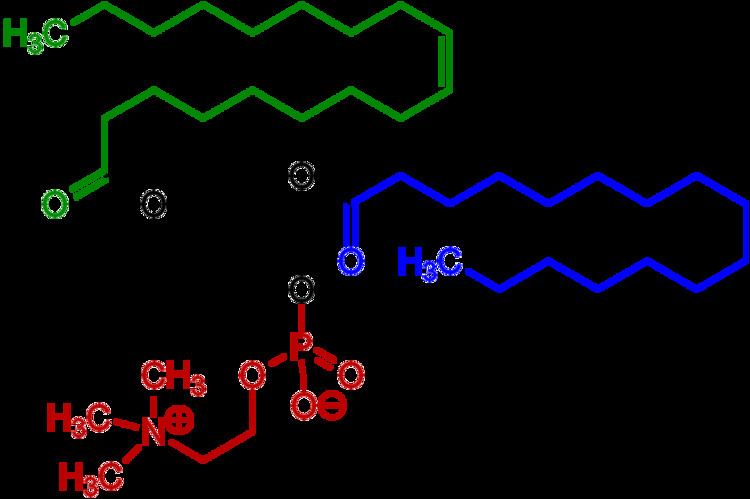
Phosphatidylcholine is a major constituent of cell membranes and pulmonary surfactant, and is more commonly found in the exoplasmic or outer leaflet of a cell membrane. It is thought to be transported between membranes within the cell by phosphatidylcholine transfer protein (PCTP).

Phosphatidylcholine also plays a role in membrane-mediated cell signaling and PCTP activation of other enzymes.
Structure and physical properties
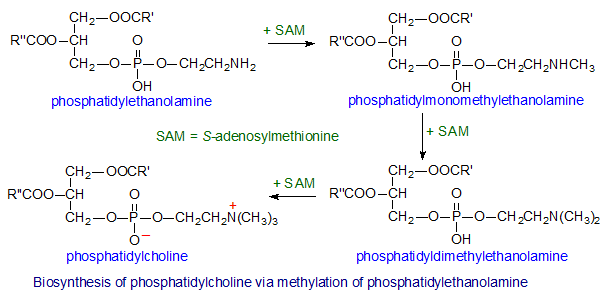
This phospholipid is composed of a choline head group and glycerophosphoric acid, with a variety of fatty acids. Usually, one is a saturated fatty acid (in the given figure, this can be palmitic or hexadecanoic acid, H3C-(CH2)14-COOH; margaric acid identified by Gobley in egg yolk, or heptadecanoic acid H3C-(CH2)15-COOH, also belong to that class); and the other is an unsaturated fatty acid (here oleic acid, or 9Z-octadecenoic acid, as in Gobley's original egg yolk lecithin). However, there are also examples of disaturated species. Animal lung phosphatidylcholine, for example, contains a high proportion of Dipalmitoylphosphatidylcholine.
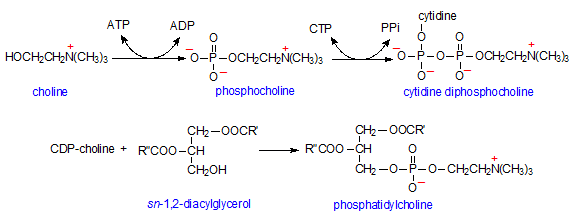
Phospholipase D catalyzes the hydrolysis of phosphatidylcholine to form phosphatidic acid (PA), releasing the soluble choline headgroup into the cytosol.
Phosphatidylcholine is a neutral lipid, but it carries an electric dipole moment of about 10 D. Vibrational dynamics of phosphatidylcholine and its hydration waters has been recently calculated from first principles.
Senescence
Phosphatidylcholine is a vital substance found in every cell of the human body. Thus, some researchers have used mutant mouse models with severe oxidative damage as a model of "accelerated aging" to investigate the possible role of phosphatidylcholine supplementation as a way of slowing down aging-related processes and improving brain functioning and memory capacity in dementia. However, a systematic review of clinical trials in humans found that there is not enough evidence to support lecithin or phosphatidylcholine supplementation for patients with dementia. The study does admit that a moderate benefit cannot be ruled out until further large scale studies are performed.
Liver repair
Recent studies have examined potential benefits of phosphatidylcholine for liver repair. Results are mixed in animal models, and no clinical evidence shows a health benefit in humans. One study shows the healing effect of phosphatidylcholine in mice with hepatitis A, hepatitis B, and hepatitis C. The administration of phosphatidylcholine for chronic, active hepatitis resulted in significant reduction of disease activity in mice.
Lipolysis
Some organizations promote the use of injected phosphatidylcholine, otherwise known as injection lipolysis, claiming the procedure can break down fat cells, and thus serve as an alternative to liposuction. While the procedure cites early experiments that showed lipolysis in cases of fat emboli, no peer-reviewed studies have shown any amount of lipolysis even remotely comparable to liposuction.
Ulcerative colitis
Phase IIa/b clinical trials performed at the Heidelberg University Hospital have shown that delayed release purified phosphatidylcholine is an anti-inflammatory agent, and a surface hydrophobicity increasing compound with promising therapeutic potential in the treatment of ulcerative colitis.
Possible health risks
A report in 2011 has linked the microbial catabolites of phosphatidylcholine with increased atherosclerosis in mice through the production of choline, trimethylamine oxide, and betaine.
